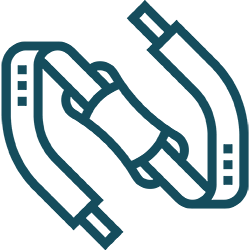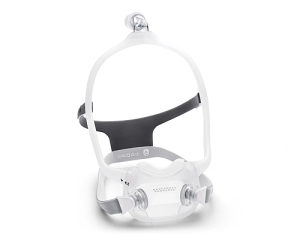- Price: $116
- Mask type: Nasal pillow
- Warranty: 90 days
- Standout feature: Top-of-head tubing
5 Best CPAP Masks for Side Sleepers Reviewed in 2025
Key Takeaways
- Our pick for the best CPAP mask for side sleepers is the Philips Respironics DreamWear Silicone Pillows mask due to its top-of-the-head tubing attachment and comfortable, secure fit.
- CPAP masks for side sleepers must allow the wearer freedom of movement while maintaining a leak-proof seal.
- The masks in this review are similarly priced, from $89–$115.
- The majority of people prefer to sleep on their sides, and this preference increases as we age.
- Doctors generally recommend side sleeping for patients with sleep apnea, making it essential to find a mask that support this position.
If you use continuous positive airway pressure (CPAP) therapy for sleep apnea, you know how important it is to have a mask that fits well and feels comfortable. Research studies have found that the majority of people prefer to sleep on their sides, and this preference increases as we age. Doctors also generally recommend side sleeping for patients with sleep apnea. But it can be tricky to find a CPAP mask that works well in a side-sleeping position. Side sleepers often struggle with keeping the mask in place, which can lead to leaks or discomfort.
Choosing the right CPAP mask means finding one that stays in place and keeps a snug seal all night long. “The development of mask technology and newer mask options has allowed us to offer CPAP treatment to more and more patients, understanding that the fit and comfort are entirely individualized,” Matt Davis, MD, medical director of Patient First MD Advanced Center for Neurodiagnostics and Sleep Dynamics, told us. “The best CPAP mask is the one that works best for you. It’s very personal.”
Our guide will introduce you to the best CPAP masks for side sleepers, highlighting options that are comfortable and effective. Let’s find the right fit for you, so you can enjoy restful, uninterrupted sleep.
Read more of our recommendations for the best CPAP masks and best CPAP machines.
Best CPAP masks for side sleepers in 2025
- Philips Respironics DreamWear Silicone Pillows: Best CPAP Mask for Side Sleepers Overall
- ResMed AirFit P10 Nasal Pillow: Best Nasal Pillow CPAP Mask for Side Sleepers
- Philips Respironics DreamWear Full Face Cushion: Best Full Face CPAP Mask for Side Sleepers
- ResMed AirFit P30i Nasal Pillow: Best CPAP Mask for Side Sleepers With Beards
- Fisher & Paykel Brevida Nasal Pillow: Best for Side Sleepers New to CPAP
What we look for in a CPAP mask for side sleepers
We found several important factors when testing CPAP masks specifically for side sleepers, including how comfortable the fit is, whether there is a strong seal, and more.

Comfortable fit
The mask should feel gentle on your skin without causing pressure points or discomfort. A well-fitted mask should help you sleep soundly through the night without needing constant adjustments.

Minimal design
A smaller mask is less likely to shift or press against the pillow while you sleep. Lightweight masks, like nasal pillows or smaller nasal masks, are ideal for side sleepers, as they offer better freedom of movement.

Secure seal
A CPAP mask needs a strong seal to prevent air leaks and ensure effective therapy. Masks with adjustable straps and soft cushions help maintain a snug fit, even when you switch sides.

Durability
The mask should withstand regular use without wearing out quickly. High-quality materials ensure the mask stays functional and comfortable for a long time, reducing the need for frequent replacements.
Philips Respironics DreamWear Silicone Pillows: Best CPAP Mask for Side Sleepers Overall
Our expert take on the Philips Respironics DreamWear Silicone Pillows Mask
The DreamWear Silicone Pillows CPAP Mask is a favorite among side sleepers because of its thoughtful design and comfort. The top-of-head tubing ensures the hose stays out of the way, allowing you to move freely and sleep in any position—including on your side—without tangling or obstruction. This unique feature also provides an unobstructed view.
The mask’s silicone pillows are designed to sit comfortably under the nose, preventing pressure on the bridge and reducing the risk of red marks and skin irritation. Users have praised the mask for its soft feel and lightweight construction, which contribute to a restful sleep experience. The DreamWear mask is available in small, medium, medium-wide, and large sizes to fit a variety of face and head shapes and ensure a secure fit and seal.
We found that this mask operates quietly, making it an excellent choice for light sleepers and people who share a bed with a partner.
Philips recommends replacing the pillow cushion every three to six months. Some online suppliers can help make this easier by sending a reminder when it’s time to order a replacement.
It’s essential to consider personal comfort and pressure requirements when choosing a nasal pillow mask. Despite their many benefits, some users report nasal dryness and nosebleeds while using their nasal pillow masks, particularly when using higher pressure settings.

DreamWear Silicone Pillows Mask standout feature
The DreamWear Silicone Pillows Mask features a top-of-head tubing design, allowing users to sleep comfortably in any position without the hose getting in the way. This design also provides an unobstructed view.
Who may love it
- Side sleepers looking for a mask with minimal face contact
- People who want an unobstructed view for reading or watching TV before bed
- Light sleepers and users sensitive to noise
Who may want to avoid it
- People who tend to experience nasal dryness or nosebleeds with CPAP therapy
- CPAP users who require high-pressure settings and find nasal pillows uncomfortable
Customer reviews
“The cushions don’t aggravate my nose, and stay put just fine. I use a sleep mask in addition to the CPAP, and I set the bottom edge of the sleep mask against the cushions and everything stays in place, even when I roll around.”
– Meredith R., Google Reviews
“My problem: I have long hair and CPAP headgear slips off the back of my head and moves my headgear & nasal pillows in the middle of the night, causing me to wake up and have to adjust them back into place, resulting in interrupted sleep. The Philips straps on the back & the design of the headgear keeps my headgear in place at night.”
– Ruby G., verified purchase on RespShop
ResMed AirFit P10 Nasal Pillow: Best Nasal Pillow CPAP Mask for Side Sleepers
Our expert take on the ResMed AirFit P10 Nasal Pillow Mask
The ResMed AirFit P10 Nasal Pillow Mask is a good option for side sleepers seeking a lightweight and small CPAP mask. Weighing only 1.6 ounces and made up of just three parts, this mask is easy to assemble and maintain. The nasal pillow cushion offers stability, ensuring the mask stays in place even when you switch sleep positions.
The mask features QuietAir vents, which significantly reduce noise, making it one of the quietest options available. This feature is particularly beneficial for light sleepers or those who share a bed. The slip-on headgear is simple to use, allowing you to watch TV or read in bed without feeling restricted.
While the AirFit P10 excels in comfort and simplicity, its design may not suit everyone. Some users may experience nasal dryness or find the mask’s adjustability limited. But for those who prefer a sleek, quiet mask with minimal face coverage, the AirFit P10 is a solid option.

ResMed AirFit P10 Nasal Pillow Mask standout feature
The AirFit P10 Nasal Pillow Mask stands out for its ultra-quiet operation and minimalist design, providing a peaceful sleeping environment without sacrificing comfort or stability.
Philips Respironics DreamWear Full Face Cushion: Best Full Face CPAP Mask for Side Sleepers
Our expert take on the Philips Respironics DreamWear Full Face Cushion Mask
While some side sleepers prefer smaller masks, others may need a full face mask. Full face masks cover the mouth, so they’re a good option for mouth breathers and those who need a CPAP mask with higher pressure settings. The Philips Respironics DreamWear Full Face Cushion mask does not fully cover the nose and mouth. Instead, it features an under-the-nose design that seals around the mouth and under the nostrils, reducing bulkiness and minimizing contact with the skin. This design helps prevent red marks and skin irritation on the face, and provides a more comfortable experience for side sleepers.
The mask’s top-of-head tubing keeps the hose out of the way, allowing users to sleep in any position without the mask or hose getting in the way. This design also provides an open line of sight.
The mask is available in four different sizes, which can help you find a secure fit. But it’s important to note that its magnetic headgear clips may not be suitable for people with certain medical devices, like pacemakers and metal implants, so consult your health care provider if you have concerns.
We liked that this mask includes both nasal pillows and a full face cushion with nasal cushions that can be easily switched out, giving users the flexibility to switch between different types of CPAP therapy using the same headgear piece.
Overall, the DreamWear Full Face Cushion offers a balance of comfort and flexibility, making it a top choice for side sleepers who prefer a full face mask.

Philips Respironics Dreamwear Full Face Mask standout feature
The DreamWear full face cushion mask’s under-the-nose construction provides minimal contact to reduce skin irritation and red marks on the nose bridge, offering a more comfortable CPAP therapy experience for some.
Who may love it
- Side sleepers who prefer or require a full face mask
- Users seeking minimal face contact and reduced skin irritation
- People who value the ability to switch between different cushion types
Who may want to avoid it
- People with certain types of medical devices that are incompatible with magnetic headgear clips
- Users who need a stronger seal provided by traditional full face masks
Customer reviews
“This mask has made all the difference compared to the stock mask and cushion set up I received with my machine. The cushion is more comfortable and the hose attachment placement has made me able to toss and turn with abandon!”
– Richard E., Lofta.com
“Great for active sleepers and comfortable. However, it is a bit noisier than the ResMed masks with diffusers.”
– Diego A., Lofta.com
ResMed AirFit P30i Nasal Pillow: Best CPAP Mask for Side Sleepers With Beards
Our expert take on the ResMed AirFit P30i Nasal Pillow Mask
We agree that the ResMed AirFit P30i Nasal Pillow Mask is a good option for side sleepers with beards or facial hair because of its lightweight and flexible design. Its top-of-head tubing keeps the hose out of the way, providing an open field of vision and the SpringFit frame contours to the shape of your face, ensuring a secure fit without the need for extensive adjustments.
The mask features QuietAir vent technology, which diffuses exhaled air quietly and efficiently, reducing noise to just 21 decibels. This makes it a great choice for light sleepers and those who share a bed. The mask’s minimal touchpoints and simple design help prevent skin irritation and red marks, even with facial hair.
While the AirFit P30i is designed to fit a wide range of users, some might experience nasal dryness due to the nasal pillow design. Using a CPAP humidifier can help. Also, this mask is not compatible with the ResMed AirMini travel CPAP machine, so travelers may need a different option for travel.
Overall, the ResMed AirFit P30i offers comfort, flexibility, and effectiveness, making it the best choice for side sleepers with beards who prefer a mask with minimal skin contact.

ResMed AirFit P30i Nasal Pillow Mask standout feature
The top-of-head tubing and SpringFit frame make it easy to move while wearing this mask without breaking the seal. This can be important for side sleepers with beards.
Who may love it
- Side sleepers with beards who are seeking a lightweight, minimal-contact mask
- Active sleepers who change positions frequently during the night
- Users who prefer a quiet mask
Who may want to avoid it
- Those who need a compatible mask for the ResMed AirMini travel CPAP machine
- Users who experience nasal dryness and prefer a different mask style
- People seeking more face coverage for added stability
Customer reviews
“I moved from the full face mask to this one. Best move I could’ve made. I can now sleep on my side without feeling the air leaking out of the mask. Very comfortable, but I’ve found I shouldn’t tighten the mask too much or it will feel uncomfortable on my nose. I look goofy in the mask but it gets the job done very well.”
– Dalon W., Lofta.com
“Have only been on a cpap for 2 months and the P30i is the only thing I’ve used so far, but I’ve had no problem getting used to it and using it the full night. I do a lot of moving around from side to side and even sleep on my stomach at times, and the P30i has never been a problem other than readjusting the nasal pillows a bit when needed.”
– Stephen Y., Lofta.com
Fisher & Paykel Brevida Nasal Pillow: Easiest to Use CPAP Mask for Side Sleepers
Our expert take on the Fisher & Paykel Brevida Nasal Pillow Mask
The Fisher & Paykel Brevida Nasal Pillow mask is designed for simplicity and comfort and is an excellent choice for side sleepers who are new to CPAP therapy. The mask features VisiBlue color-coded parts, which make assembly and disassembly straightforward, and maintenance and cleaning easier for the user. This feature is particularly beneficial for those who may struggle with more complex mask designs.
The soft AirPillow cushions inflate to create a gentle, secure seal around the nostrils, minimizing the risk of skin redness and irritation. This design can provide comfort and stability, allowing users to switch sleep positions without moving the mask out of place. The Quiet Sleep Vent Diffuser softly disperses exhaled air, reducing noise and preventing disturbances during sleep.
The Brevida’s flexible headgear is lightweight and designed to contour to the shape of the head, providing a secure but comfortable fit with minimal face contact. This design is good for people who feel claustrophobic with larger masks or prefer an open field of vision.
The Brevida may not be suitable for those who require higher pressure settings. Also, the limited size options might not fit every user comfortably, so it’s important to try both of the available sizes to ensure the best fit.

Fisher & Paykel Brevida Nasal Pillow Mask standout feature
The VisiBlue color-coded parts make the Brevida incredibly easy to assemble, disassemble, and maintain. It’s a good option for people who are new to CPAP therapy.
Who may love it
- Side sleepers looking for a user-friendly mask with minimal parts
- Users who want a quiet mask for a peaceful sleep environment
Who may want to avoid it
- Users who need a mask with high pressure settings
- Those who prefer more face coverage for added stability
- People who require a wider range of size options for a right fit
- Those who prefer a top-of-the-head hose attachment
Customer reviews
“I really like this mask a lot. Simple and comfortable. I switch between different masks but this is my current favorite. I pair it with a chin strap just to help with mouth breathing.”
– Cheryl K., Lofta.com
“These nasal pillows are comfortable and easy to snap in and remove. I’ve had no issues in my first month of using them.”
– Judy R., Lofta.com
How we review CPAP products
Our team dedicated more than 250 hours to researching CPAP machines, masks, and accessories, including 15 brands and 18 different CPAP masks. This research included comparing the product specifications, features, and performance to determine the best options for different types of sleep apnea. We also used the findings from our survey of 600 CPAP users about their experiences with different devices and masks to make our recommendations.
We reviewed each CPAP mask based on:
- Cost
- Type of mask
- Adjustability
- Ease of use and cleaning
- Comfort
- Noise level
- Line of vision
These factors were chosen to reflect the needs and preferences of our audience, especially older adults seeking reliable and comfortable sleep apnea solutions.
By combining expert opinions, comprehensive research, customer feedback, and academic insights, we recommend CPAP masks that can truly benefit our readers. Our goal is to help people make informed decisions about their sleep apnea treatment options, leading to better sleep quality and improved overall health.
We also had all of our selections medically reviewed by an expert in the field to ensure that each brand and model is appropriate for our readers’ needs.
To learn more about our testing, review our CPAP methodology.
What to consider when purchasing a CPAP mask for side sleepers
Choosing the right CPAP mask is key to successful sleep apnea treatment, especially for side sleepers. The right mask should fit well, feel comfortable, and work with your CPAP machine. Before making a purchase, consider factors such as size, comfort, compatibility, and professional guidance. These elements will help you get the best mask for your needs and sleep position.
Size and fit
The mask’s size and fit are important for comfort and effectiveness. A mask that is too loose may leak air, while one that is too tight can cause discomfort, skin redness, and indentations on the skin. Look for adjustable straps and cushions that conform to your face’s contours. Trying on different sizes and styles can help you find a mask that feels secure and stays in place as you move throughout the night.
Mask comfort
Choose a mask with soft materials that feel gentle against your skin. Masks with minimal contact points, like nasal pillows, can reduce skin irritation and allow for easier movement while sleeping. A design with fewer parts can help prevent pressure against your face when lying on your side.
Hose position
Masks with top-of-head tubing, like the Philips DreamWear Silicone Pillows and the ResMed AirFit P30i, allow for greater freedom of movement and vision, which is good for those who change positions frequently, or who like to read or watch TV in bed. On the other hand, masks with front-of-face hose connections may suit users who prefer a more traditional design or who don’t move as much during the night. Davis told us that side sleepers often prefer top-of-head tubing, which was specifically designed for side sleeping. Consider your sleeping habits and comfort preferences when selecting the hose position that will work best for you.
Machine compatibility
Ensure your mask is compatible with your CPAP machine. Most masks fit standard CPAP tubing, but it’s a good idea to double-check compatibility before buying a new mask to avoid the hassle of returning it. Some masks work better with specific machines or pressure settings, so reviewing your machine’s specifications can help you make the right choice. If you’re still unsure after reading your machine’s user guide, call the machine manufacturer’s customer service to get more information and advice.
Doctor’s recommendation
You need a prescription in order to purchase a CPAP mask. Your doctor or sleep specialist can provide recommendations for the best mask options and help you to determine the mask style that suits your sleep habits and pressure requirements. Professional guidance can make your search for the right CPAP mask easier, ensuring you receive the best possible treatment.
What type of CPAP mask is best for side sleepers?
The best mask for you depends on your comfort preferences, how you breathe while sleeping, and your CPAP therapy needs. Each mask type offers unique benefits for side sleepers. Here are the most common mask types to help you decide which one might be the best fit for your needs.
Nasal masks
Nasal masks cover the nose and create a seal around the bridge and upper lip. They offer a balance of comfort and effectiveness, making them popular among side sleepers. These masks work well at higher pressure settings and provide a secure seal that helps prevent air leaks. But this design may not be ideal for people with nasal congestion or a deviated septum.
Nasal pillow masks
Nasal pillow masks are lightweight and compact and are generally a great option for side sleepers. They use small cushions that sit directly under the nostrils, minimizing contact with the face. This design reduces pressure on the cheeks and allows for greater freedom of movement. Nasal pillow masks are good for those who prefer a less bulky option and who do not require high pressure settings. That’s because nasal pillow masks can cause nostril irritation (e.g., dryness and bleeding) with high air pressures.
Full face masks
Full face masks cover both the nose and mouth, providing a secure seal for people who breathe through their mouth while sleeping. While these masks are bulkier, some models offer features that work for side sleeping, like soft cushions and adjustable straps. Full face masks are suitable for people who need higher pressure settings or have chronic nasal issues.
Compare the best CPAP masks for side sleepers as of 2025
| Price | $116 | $105 | $129 | $115 | $109 |
| Mask type | Nasal pillow | Nasal pillow | Full face | Nasal pillow | Nasal pillow |
| Warranty | 90 days | 90 days | 90 days | 90 days | 90 days |
Bottom line
Selecting the right CPAP mask that fits your sleeping style and facial features can improve sleep quality and ensure effective CPAP therapy. Each of the best CPAP masks for side sleepers in this review offer unique features to support different needs. We chose the Philips DreamWear Silicone Pillows mask as the best overall for its comfort and flexibility. The ResMed AirFit P10 Nasal Pillow excels as the best nasal pillow mask, offering a quiet and lightweight design. The ResMed AirFit P30i mask is the best choice for side sleepers with beards, due to its top-of-head tubing and unobtrusive fit. The Fisher & Paykel Brevida stands out as the easiest-to-use mask for new users, featuring easy to assemble color-coded parts. Lastly, our team chose the Philips Respironics DreamWear Full Face Cushion for providing comfort with minimal face contact, making it our pick for the best full face mask. Work with your doctor to find the right CPAP mask for you.
Want to learn more about CPAP masks and therapy? Read our articles that explain CPAP ramp time, CPAP costs, and the best travel CPAP machines. If you sleep on your side, you can also explore our review of the best mattresses for side sleepers.
Frequently asked questions
Yes, you need a prescription to purchase a CPAP mask. The prescription ensures you receive the appropriate mask and machine settings for your specific needs. Your doctor or sleep specialist can help you determine the best type of mask and pressure settings based on your diagnosis and sleep study results.
The cost of CPAP masks for side sleepers varies depending on the type, brand, and features. On average, prices range from $50–$200. Nasal pillow masks are typically on the lower end of the price range, while full face masks with advanced features generally cost more. The price range for masks in this review is from $89 to $115. It’s important to invest in a mask that is comfortable and fits well to ensure effective therapy.
Yes, CPAP users can sleep on their sides. In fact, side sleeping is often recommended for people with sleep apnea, as it can help keep the airway open. Choosing the right CPAP mask designed for side sleepers can make sleeping in this position more comfortable and effective. Masks with minimal design and a secure seal are ideal for side sleepers, as they help reduce air leaks and discomfort.
Have questions about this review? Email us at reviewsteam@ncoa.org.

Sources
- Skarpsno ES, et al. Sleep Positions and Nocturnal Body Movements Based on Free-Living Accelerometer Recordings: Association with Demographics, Lifestyle, and Insomnia Symptoms. Nature and Science of Sleep. Nov. 1, 2017. Found on the internet at https://www.ncbi.nlm.nih.gov/pmc/articles/PMC5677378/
- National Heart, Lung, and Blood Institute. Sleep Apnea Treatment. Sept. 6, 2023. Found on the internet at https://www.nhlbi.nih.gov/health/sleep-apnea/treatment







